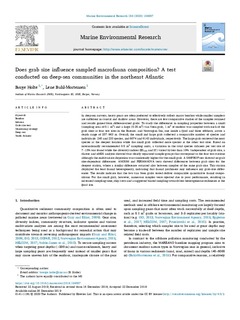| dc.description.abstract | In deep-sea surveys, heavy gears are often preferred to effectively collect macro benthos while smaller samplers are sufficient in coastal and shallow areas. However, there are few comparative studies of the samples retained and results gained from different-sized grabs. To study the differences in sampling properties between a small (sampling area of 0.1 m2) and a large (0.25 m2) van Veen grab, 1 m2 of seafloor was sampled with each of the grab sizes at four test sites in the Barents- and Norwegian Sea; one inside a fjord and three offshore, across a depth range of 287–963 m. Overall, the small and large grab collected a comparable number of species and individuals: 248 and 233 species, and 6074 and 6143 individuals, respectively. The large grab retrieved the most species at the deepest location while the small grab collected more species at the other test sites. Based on internationally recommended 0.5 m2 sampling units, a variation in the total species richness per test site of 7–13% was found while the diversity indices (ES100 and H′) varied by less than 10%. Independent of grab size, a cluster and nMDS analysis showed four clearly separated sample-groups that correspond to the four test stations although the multivariate dispersion was consistently higher for the small grab. A SIMPROF test showed no grab size-dependent differences. ANOSIM and PERMANOVA tests showed differences between grab sizes for the deepest station, where a similar difference occurred also between samples of the same grab size. This station displayed the least faunal heterogeneity, indicating that faunal patchiness may influence any grab-size differences. The results indicate that the two van Veen grabs tested deliver comparable quantitative faunal compositions. For the small grab, however, numerous samples were rejected due to poor performance, resulting in increased sampling time, ship costs and a suggested biased sampling towards less heterogeneous sediments at the fjord site. | nb_NO |
